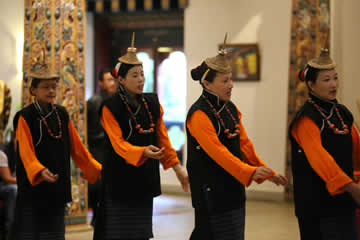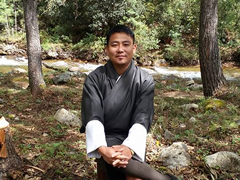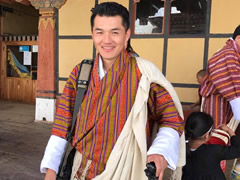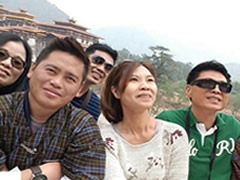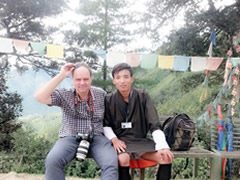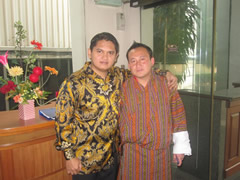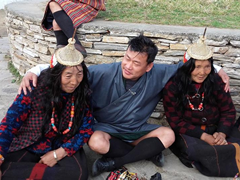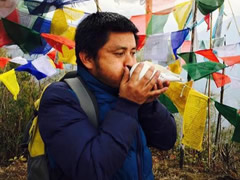Punakha Dzong which is also known as Puntang Dechen Phodrang Dzong, which means the Palace of Great Bliss / Happiness. The first King of modern Bhutan was crowned in Punakha Dzong. Punakha Dzong remained the center of government until it was relocated to Thimphu. In 2011, the wedding of the 5th King was held in this fortress.
Best time to visit: May. Jacaranda flowers will be blooming in the courtyard of the fortress.
What will be going to see in Punakha:
Places to visit at Punakha / Punakha Sightseeing's
Punakha Dzong
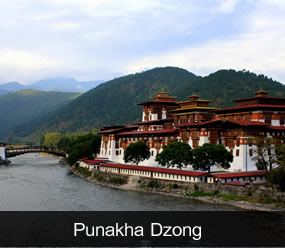 Popularly known as the Punakha Dzong, Punthang Dechen Phodrang (The Palace of Great Bliss/ Happiness) was built in 1637 by the Zhabdrung Ngawang Namgyel. Punakha Dzong is the most beautiful Dzong in the country, especially in spring when the flower of the Jacaranda trees brings a very sweet smel to the Dzong's. This Dzong was the second to be built in Bhutan and it served as the capital seat of government until the mid-1950s. Punakha valley has a pleasant climate with warm winters and hot summers. It is located at an average elevation of 1200 meters above sea level. Owing to the favorable climatic conditions, rice grows very well in this region and is the main cash crop cultivated here.
Popularly known as the Punakha Dzong, Punthang Dechen Phodrang (The Palace of Great Bliss/ Happiness) was built in 1637 by the Zhabdrung Ngawang Namgyel. Punakha Dzong is the most beautiful Dzong in the country, especially in spring when the flower of the Jacaranda trees brings a very sweet smel to the Dzong's. This Dzong was the second to be built in Bhutan and it served as the capital seat of government until the mid-1950s. Punakha valley has a pleasant climate with warm winters and hot summers. It is located at an average elevation of 1200 meters above sea level. Owing to the favorable climatic conditions, rice grows very well in this region and is the main cash crop cultivated here.
All of Bhutan's kings have been crowned here. The Dzong is still the winter residence of the dratshang (official monk body).
History
In the 8th century, Guru Rinpoche had prophesied that a young man named Namgyal would come to a mountain that appeared like a sleeping elephant and build a Dzong upon the elephant’s trunk. To fulfill his prophecy, Zhandrung Ngawang Namgyel gathered all the people in Punakha valley to construct the Dzong but nobody was able to construct. There was a man called Zow Balep and he stood up and answered show me the sample, so that he can construct the Dzong. During that time Simtokha Dzong was the only Dzong that they have the architecture.
So Zhabdrung Ngawang Namgyel asked Zow Balep to sleep under under a small structure which contained a statue of the Buddha, known as Dzong Chug "small dzong". So Zhabdrung Ngawang Nangay out his supernatural power liberated Zow Balep to the paradise of Guru Rinpoche and made him the clear vision of the Paradise of Guru Rinpoche. So the Zow Balep started designing the same architecture as that of the paradise of Guru Rinpoche with the help of sand and radish. On the basis of the dream vision of the architect, the building of the dzong was started in 1637 and completed in 1638, at the place where the Dzong Chug had existed.
People came from all parts of Bhutan to help Zhabdrung and Zow Palep. The Zhabdrung was deeply impressed both by gathering of people as well as by the variety of products, particularly the food products from different parts of Bhutan. He concluded that the occasion was a very good omen. The Zhabdrung asked the gathering to be seated in rows and served the food items bought from different parts of the country. The meal thus hosted by Zhabdrung during the inauguration of the Punakha Dzong and ceremony was known as ‘ Zhungdrel Phuensum Tshogpa’ literally means coming together and sitting in rows of all the good thing’s .
But unfortunately the Dzong got destroyed many times by fire, by flood and earthquake but the recent destruction was in the year 1994 due to flood from the phochu (Male River) where it lost the lives of 21 people. That’s why the royal Government of Bhutan has relocated the new Town to Khuruthang and the Dzong has to do renovation. Still then we consider the Punakha Dzong as one of the most beautiful and important Dzong because it has so many history and relics inside. The most important relics Rangjung Khasharpani – that Zhabdrung Ngawang Namgyel brought from Tibet or the causes of war between Tibet and Bhutan is also seen in Punakha Dzong which they show to the public only once in a year. The body emblem of Zhabdrung Ngwang Namgyel who passed away in the year 1651 is still seen inside the Dzong. The death body of Zhabdrung Ngawang Namgyel was kept secret to protect from the Tibetan invaders because if Tibetan knew about his death then there is chances they may attack again and also there is chances of the political issues within the country.
The first coronation of the first King was held there in Punakha dzong in the year 1907 and the architecture itself is believed to be bought from the paradise of Guru Rinpoche. So once you visit Punakha Dzong , you should feel proud that you have got to visit the paradise of Guru Rinpoche.
Now the Dzong function as district administrative body and the monastic body.
During 17th century Bhutan was invaded several times by Tibetan forces seeking to seize a very precious relic, the Ranjung Kharsapani. Zhabdrung Ngawang Namgyal led the Bhutanese to victory over the Tibetans and to commemorate the triumph he introduced the Punakha Drubchen. Since then Punakha Drubchen (also known as Puna Drubchen) became the annual festival of Punakha Dzongkhag.
The Punakha Drubchen is a unique festival because it shows the whole story of how Bhutan got the victory from Tibet . The ‘pazaps’ or local militia men, dress in traditional battle gear and reenact the ancient battle scene. This reenactment harkens back to the time when in the absence of a standing army, men from the eight Tshogchens or great village blocks of Thimphu came forward and managed to expel the invading forces from the country.
In 2005 another festival known as Punakha Tshechu was introduced by the 70th Je Khenpo Trulku Jigme Choedra and the then Home Minister His Excellency Lyonpo Jigme Yoedzer Thinley. The Tshechu was introduced in response to the requests made by Punakha District Administration and local peopleto host a Tshechu in order to better preserve Buddhist teachings and keep alive the noble deeds of Zhabdrung Rimpoche.
These two festivals not only play an important role in preserving Bhutan’s rich culture and traditions but also provide devout Buddhists with an opportunity for prayer and pilgrimage. They reflect the richness of the Bhutanese cultural heritage and are very special in the eyes and hearts of both Bhutanese and tourists who visit Bhutan.
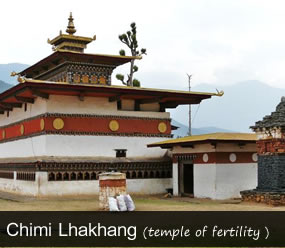 Chime Lhakhang or the Temple of fertility stands between Punakha and Wangdue. It was built in 1499 by the 14th Drukpa, Ngawang Choegyel, after the site was blessed by the “Divine Madman” or the Drukpa Kuenley who built a chorten on the site after burring the two female demons. Lama Drukp Kinley was a great Buddhist saint with extraordinary spiritual power. He used his phallus as a medium to subdue and discipline the evil spirits. Thousands of people visit Chimi Lhakhang either to pray for children by those who are childless or to seek protection for children that they already have.
Chime Lhakhang or the Temple of fertility stands between Punakha and Wangdue. It was built in 1499 by the 14th Drukpa, Ngawang Choegyel, after the site was blessed by the “Divine Madman” or the Drukpa Kuenley who built a chorten on the site after burring the two female demons. Lama Drukp Kinley was a great Buddhist saint with extraordinary spiritual power. He used his phallus as a medium to subdue and discipline the evil spirits. Thousands of people visit Chimi Lhakhang either to pray for children by those who are childless or to seek protection for children that they already have.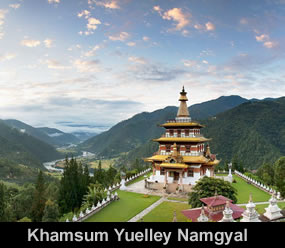 Khamsum Yuley Namgay Chorten was built in 1990s and took period of nearly 10 years. It was built by Queen Mother and dedicated to the King and for the well being of Bhutanese.Standing regally on the hill above the Punakha valley, Khamsum Yulley Namgyal Chorten is a classic example of gorgeous traditions and architecture of Asian country. This chorten, however, is unique. It is not designed for community worship or for monastic retreat or education like other Buddhist Institute and Colleges.
Khamsum Yuley Namgay Chorten was built in 1990s and took period of nearly 10 years. It was built by Queen Mother and dedicated to the King and for the well being of Bhutanese.Standing regally on the hill above the Punakha valley, Khamsum Yulley Namgyal Chorten is a classic example of gorgeous traditions and architecture of Asian country. This chorten, however, is unique. It is not designed for community worship or for monastic retreat or education like other Buddhist Institute and Colleges.

